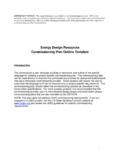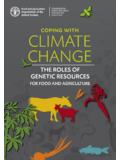Transcription of KINCARDINE OFFSHORE WIND FARM SOUTH EAST OF …
1 KINCARDINE OFFSHORE WIND FARM SOUTH EAST OF ABERDEEN scoping Opinion 2 Contents Introduction Aim of scoping Description of your Development Land use planning Natural Heritage General issues Contents of the Environmental Statement Archaeology and Cultural Heritage Navigation Ecology, Biodiversity and Nature conservation Water Environment Other Material Issues General Issues Annex 1 Consultee Comments Annex 2 Royal Yachting Association Position Statement Annex 3 Scottish Canoe Association Renewable Energy Policy Annex 4 Checklist 3 THE ELECTRICITY WORKS (ENVIRONMENTAL IMPACT ASSESSMENT) (SCOTLAND) REGULATIONS 2000 THE MARINE WORKS (ENVIRONMENTAL IMPACT ASSESSMENT) REGULATIONS 2007 scoping OPINION FOR THE PROPOSED SECTION 36 CONSENT AND ASSOCIATED MARINE LICENSE(S) APPLICATION FOR KINCARDINE OFFSHORE Wind Farm, SOUTH east of Aberdeen 1.
2 Introduction I refer to your letter of 16th April 2014 requesting a scoping opinion under The Electricity Works (Environmental Impact Assessment) (Scotland) Regulations 2000 enclosing a scoping report. Any proposal to construct or operate an OFFSHORE power generation scheme with a capacity in excess of 1 megawatt, within Scottish Territorial Waters, requires Scottish Ministers consent under section 36 of The Electricity Act 1989. Schedule 9 of the Act places on the developer a duty to have regard to the desirability of preserving natural beauty, of conserving flora, fauna and geological or physiographical features of special interest and of protecting sites, buildings and objects of architectural, historic or archaeological interest . In addition, the developer is required to give consideration to the Scottish Planning Policy on Renewable Energy other relevant Policy and National Policy Planning Guidance, Planning Advice Notes, the relevant planning authority s Development Plans and any relevant supplementary guidance.
3 Under The Electricity Works (Environmental Impact Assessment) (Scotland) Regulations 2000, Scottish Ministers are required to consider whether any proposal for an OFFSHORE device is likely to have a significant effect on the environment. Scottish Ministers have considered your request for an opinion on the proposed content of the Environmental Statement (ES) in accordance with regulations and in formulating this opinion Scottish Ministers have consulted with the relevant organisations. Please note that the Environmental Impact Assessment (EIA) process is vital in generating an understanding of the biological and physical processes that operate in the area and those that may be impacted by the proposed OFFSHORE wind farm. We would however state that references made within the scoping document with regard to the significance of impacts should not prejudice the outcome of the EIA process.
4 It is important that any devices to exploit renewable energy sources should be accompanied by a robust assessment of its environmental impacts. The assessment should also consider how any negative environmental impacts could be avoided or minimised, through the use of mitigating technologies or regulatory safeguards, so that the quality and diversity of Scotland s wildlife and natural features are maintained or enhanced. Scottish Ministers welcome the commitment given in the report that the EIA process will identify mitigation measures in order to avoid, minimise or reduce any adverse impacts. Marine Scotland 4 Licensing Operations Team (MS-LOT) would suggest that the range of options considered should be informed by the EIA process in order that these objectives can be achieved.
5 Consultation with the relevant nature conservation agencies is essential and it is advised that this is undertaken as appropriate. 2. Aim of this scoping Opinion Scottish Ministers are obliged under the EIA regulations to respond to requests from developers for a scoping opinion on outline design proposals. The purpose of this document is to provide advice and guidance to developers collated from expert consultees selected by the Scottish Government. It provides clear advice enabling developers to address issues identified with the proposed project. The advice steers the developer as to the content required in the EIA and the ES associated with the application for section 36 consent. 3. Description of development KINCARDINE OFFSHORE Windfarm Limited (KOWL) is a proposed demonstrator floating OFFSHORE wind farm (OWF) development that is located to the SOUTH east of Aberdeen, approximately 15 km (8 nm) from the Kincardineshire coast at its closest point.
6 The development is considered a commercial demonstrator site, which will utilise floating semi-submersible technology to install approximately eight wind turbine generators (WTG) of 6MW (or larger) each, in approximately 45 to 143 m of water. KOWL are currently working with Pilot OFFSHORE Renewables Ltd. (PORL) and Atkins Ltd to develop this OFFSHORE wind farm which will produce an installed capacity of up to 50 MW, with grid connection to Redmoss substation located to the SOUTH of Aberdeen. 4. Land Use Planning The Scottish Government s planning policies are set out in the National Planning Framework, Scottish Planning Policy, Designing Places and Circulars. The National Planning Framework is the Scottish Government s Strategy for Scotland s long term spatial development. Scottish Planning Policy (SPP) is a statement of Scottish Government policy on land use planning and contains: The Scottish Government s view of the purpose of planning, the core principles for the operation of the system and the objectives for key parts of the system, statutory guidance on sustainable development and planning under Section 3E of the Planning etc.
7 (Scotland) Act 2006, concise subject planning policies, including the implications for development planning and development management, and The Scottish Government s expectations of the intended outcomes of the planning system. Other documents which may be relevant to this proposal include, but are not limited to, the following: PAN 50: Controlling the Environmental Effects of Surface Mineral Workings 5 PAN 51: Planning, Environmental Protection and Regulation PAN 60: Planning for Natural Heritage PAN 62: Radio Telecommunications PAN 68: Design Statements PAN 69: Planning and Building Standards Advice on Flooding PAN 75: Planning for Transport PAN 79: Water and Drainage PAN 1/2011: Planning and Noise PAN 2/2011: Planning and Archaeology PAN 1/2013: Environmental Impact Assessment Marine Guidance Note 371 (M) Aberdeen City and Shire Strategic Development Plan 2014 Aberdeenshire Local Development Plan 5.
8 Natural Heritage Scottish Natural Heritage (SNH) has produced a Service Level Statement (SLS) for renewable energy consultation. This statement provides information regarding the level of input that can be expected from SNH at various stages of the EIA process. Annex A of the SLS details a list of references, which should be fully considered as part of the EIA process. A copy of the SLS and other vital information can be found on the renewable energy section of their website 6. General Issues Economic Benefit The concept of economic benefit as a material consideration is explicitly confirmed in the consolidated SPP. This fits with the priority of The Scottish Government to grow the Scottish economy and, more particularly, with our published policy statement Securing a Renewable Future: Scotland s Renewable Energy , and the subsequent reports from the Forum for Renewables Development Scotland (FREDS), all of which highlight the manufacturing potential of the renewables sector.
9 The application should include relevant economic information connected with the project, including the potential number of jobs, and economic activity associated with the procurement, construction operation and decommissioning of the development. 7. Contents of the Environmental Statement Guidance can be found in The Marine Works (Environmental Impact Assessment) Regulations 2007, Schedule 3 Format Developers should be aware that the ES should also be submitted in a user-friendly PDF format which can be placed on The Scottish Government website. A description of the methodology used in assessing all impacts should be included. It is considered good practice to set out within the ES the qualifications and experience of all those involved in collating, assessing or presenting technical information.
10 Non-Technical Summary 6 This should be written in simple non-technical terms to describe the various options for the proposed development and the mitigation measures against the potential adverse impacts which could result. Within an ES it is important that all mitigating measures should be: clearly stated; fully described with accuracy; assessed for their environmental effects; assessed for their effectiveness; their implementation should be fully described; how commitments will be monitored; and if necessary, how they relate to any consents or conditions Given that the layout and design are still developing and evolving, the exact nature of the work that is needed to inform the EIA may vary depending on the design choices. The EIA must address this uncertainty so that there is a clear explanation of the potential impact of each of the different scenarios.






